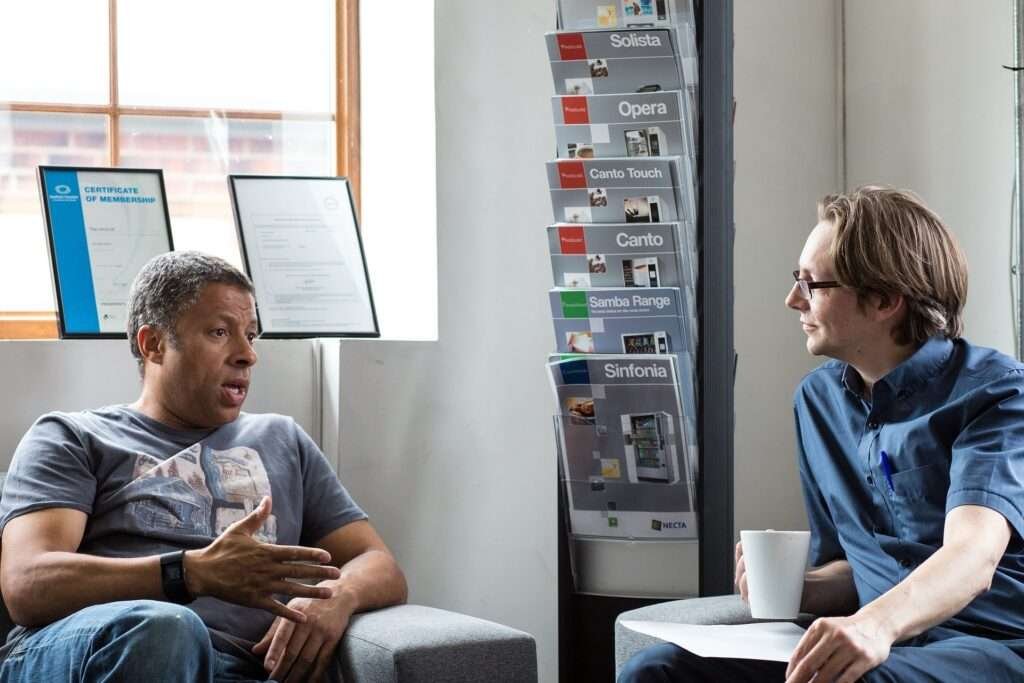Do you want to be able to have a good conversation with anyone? Then you’re not alone. A lot of people struggle with having interesting conversations with others. At the same time, we all need good social connections, such as friends, to feel socially fulfilled. Being a good conversationalist also opens doors in your career, so it’s incredibly important to master this skill. Use the 4 strategies below to give your conversations a power-up!
Table of Contents

1. Listen With Full Attention
This one is big. Many people don’t really listen when they are talking to others. They are more preoccupied with their own thoughts, or they are waiting on their turn to speak. Their focus is on the inside (internal attention).
That is not a good attitude when you are trying to create a meaningful conversation. Focus your entire attention on the other person instead (external attention). Listen carefully to what he or she is saying, their tone of voice, their posture.
Try to minimize any distraction, especially your phone. Almost nothing kills a conversation as well as someone grabbing their smartphone and staring at the screen, perhaps even sending a text message or two.
If you do that, you’re conveying to the other person that he or she is not important. If, instead, you choose to listen with full attention, you convey to that person that what they are saying is of importance to you, and that you care.
Another way to show that you’re listening is to ask clarifying questions or summarize what the other person has said to ensure that you’ve understood them correctly.

2. Ask Questions
The center of a good conversation is genuine interest. This is also an important principle in Carnegie’s book How To Win Friends And Influence People. When both parties are genuinely interested in each other’s lives or the topic of the conversation, things will flow naturally.
Be curious and show interest by asking questions. Asking open-ended questions is a great way to keep the conversation flowing and to learn more about the other person. Instead of asking yes or no questions, try asking questions that require a more thoughtful response. For example, instead of asking “Did you have a good weekend?” try asking “What did you do over the weekend?”
A good conversation is also balanced. So don’t make it an interview by asking question after question, never giving the other person the opportunity to ask you a question or never telling something about yourself. Give the other person some space in the conversation. Be sure to check out our guide on how to never run out of things to say if you’d like to know more.
If you notice that the other person shows no interest in you, don’t immediately view that as a failure on your side. Sometimes people just aren’t interested in talking, or are not good at keeping a conversation. It takes two to tango, and you can’t force someone to be interested in you. If you also notice that their body language shows disinterest, like them looking away or turning their body away from you, slowly disengage, as it is likely the other person is not interested in having a conversation.

3. Share About Yourself
Besides asking questions, it is also vital to share some things about yourself to the other person. If you do this right, a nice flow starts to develop where both parties share things about themselves and ask questions to each other.
Sharing your own experiences can help to build a connection with the other person and make the conversation more meaningful. For example, if someone is telling you about a difficult experience they had, you might share a similar experience you had and how you overcame it. This can help to establish common ground and create a sense of shared experience.
Now, what should you share about yourself? Especially when you’ve just met someone it can be easy to overshare. This happens when you share more about yourself than is appropriate for the relationship you have with that person. Generally speaking, subjects like medical conditions, your romantic relationships, and deeply emotional events can best be saved for intimate relationships, like your (close) friends.
So, we don’t want to overshare. But what is appropriate? This really depends on the level of your relationship with that person. If you just met someone, talking about ‘safe’ subjects, like hobbies, is a great way to build rapport and get to know someone.
After talking to someone for a longer time, you can trickle in a few more personal subjects and see whether they reciprocate. If they do, good, then you can go a little step further. But if they are closed off and don’t reciprocate, take that as a message that they’d rather keep the conversation more on a surface-level.
Some common topics, using temperature as a gauge of intimacy:
- Cool: hobbies, work, weather, sports, food, travelling, pets.
- Warm: family, friends.
- Hot: physical conditions, dating life, personal finances.
- Scorching: mental problems, traumas.
So start off at the lowest temperature, and slowly head to the higher tiers if you want to and the other person reciprocates. If someone brings up a controversial topic, you might gently redirect the conversation by saying something like, “I can understand why you feel that way, but I prefer not to discuss that particular topic. I’d much rather talk about …”

4. Use Non-Verbal Communication
When we think about communication, we often focus on the words we use to express ourselves. However, non-verbal communication can be just as important when it comes to having good conversations with others. So how can we have a good conversation through non-verbal communication? Here are some tips:
Maintain Eye Contact
Maintaining eye contact is one of the most important non-verbal cues you can use when communicating with others. Looking someone in the eye when you’re speaking to them shows that you’re engaged and interested in what they have to say. It also helps build trust and rapport. Eye contact can also convey confidence, sincerity, and respect. Conversely, avoiding eye contact signals discomfort, shyness, or dishonesty. Now, you don’t want to stare at someone for the entire conversation, as that is too intense, so occasionally break eye contact for a second.
Use Facial Expressions
Your facial expressions can convey a lot of information about how you’re feeling and what you’re thinking. Smiling, nodding, and raising your eyebrows can all signal that you’re listening and engaged. Using facial expressions can help communicate your emotions and show that you understand and empathize with the other person. However, it is important to be genuine with your facial expressions; otherwise, you may come across as insincere or untrustworthy.
Pay Attention to Your Body Language
Your posture, gestures, and movements can all communicate messages to the other person. Try to keep an open and relaxed posture, and use gestures to emphasize your points. Crossing your arms or legs, leaning back, or fidgeting can all signal defensiveness, boredom, or discomfort. On the other hand, leaning in, nodding, and gesturing with your hands can all show that you’re engaged and interested.
Be Aware of the Other Person’s Non-Verbal Cues
Just as you’re using non-verbal communication to send messages, the other person is doing the same. Pay attention to their facial expressions, body language, and tone of voice to better understand what they’re trying to say. For example, if someone is avoiding eye contact or has closed body language, they may be feeling defensive or uncomfortable. Conversely, if someone is nodding or leaning in, they may be interested or agreeable. By being aware of these cues, you can adjust your own communication to be more effective.
Conclusion: How To Have A Good Conversation With Anyone
In conclusion, having a good conversation requires listening with full attention, asking open-ended questions, sharing about yourself, and using good non-verbal communication. By following these tips, you can create meaningful and positive connections with others and have more fulfilling conversations.
ACTION POINTS
- Focus your attention on the other person instead of yourself
- Minimize distractions while having a conversation
- Ask open-ended questions with genuine interest
- Share about yourself without oversharing
- Use non-verbal cues like eye contact and body language




